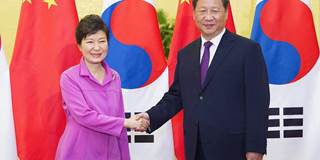Last week, South Korean President Park Geun-hye stood together with Chinese President Xi Jinping to watch the parade commemorating the 70th anniversary of the end of WWII in Asia. Although Park's decision to attend drew the ire of the US and Japan, it actually reflects a more forward-thinking approach to regional affairs.
BEIJING – Last week, South Korean President Park Geun-hye, despite the opposition of her country’s closest ally, the United States, stood together with Chinese President Xi Jinping in Tiananmen Square to watch the military parade commemorating the 70th anniversary of World War II’s end in Asia. The decision provided the most visible image yet of an emerging China-South Korea concert, one that China believes may prevent the region from sliding into cold war.

BEIJING – Last week, South Korean President Park Geun-hye, despite the opposition of her country’s closest ally, the United States, stood together with Chinese President Xi Jinping in Tiananmen Square to watch the military parade commemorating the 70th anniversary of World War II’s end in Asia. The decision provided the most visible image yet of an emerging China-South Korea concert, one that China believes may prevent the region from sliding into cold war.